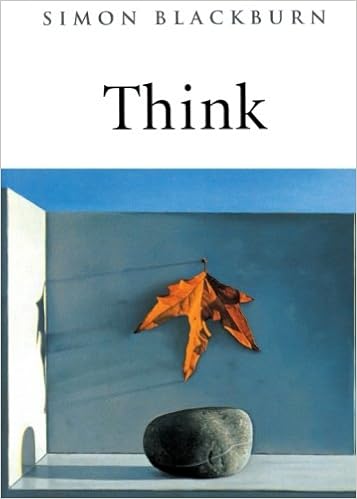It has develop into more and more tricky to disregard the ways in which the centrality of recent media and applied sciences ― from the worldwide networking of knowledge platforms and social media to new percentages for changing human genetics ― appear to make out of date our conventional methods of pondering ethics and persuasive conversation inherited from past humanist paradigms. This booklet argues that instead of devoting our serious energies in the direction of critiquing humanist touchstones, we should always as a substitute research the ways that media and applied sciences have regularly labored as an important cultural forces in shaping ethics and rhetoric. Pruchnic combines this historic itinerary with serious interrogations of various cultural and technological websites ― the good judgment of games and synthetic intelligence, the ethics of lifestyles extension in modern drugs, the transition to computer-automated buying and selling in international inventory markets, the kingdom of severe idea within the modern humanities ― besides cutting edge analyses of the works of such figures because the Greek Sophists, Kenneth Burke, Martin Heidegger, Michel Foucault, Friedrich Nietzsche, and Gilles Deleuze. This publication argues that our greatest thoughts for crafting persuasive conversation and generating moral kin among participants might be those who creatively reflect and acceptable, instead of face up to, the logics of dominant types of media and technology.
Preview of Rhetoric and Ethics in the Cybernetic Age: The Transhuman Condition PDF
Similar Philosophy books
'One has to be enhanced to mankind in strength, in loftiness of soul—in contempt’In those devastating works, Nietzsche deals a sustained and sometimes vitriolic assault at the morality and the ideals of his time, particularly these of Hegel, Kant and Schopenhaur. Twilight of the Idols is a ‘grand assertion of conflict’ on cause, psychology and theology that mixes hugely charged own assaults on his contemporaries with a lightning travel of his personal philosophy.
Think: A Compelling Introduction to Philosophy
The following ultimately is a coherent, unintimidating advent to the demanding and interesting panorama of Western philosophy. Written expressly for "anyone who believes there are huge questions available in the market, yet doesn't know the way toapproach them," imagine presents a valid framework for exploring the main simple subject matters of philosophy, and for realizing how significant philosophers have tackled the questions that experience pressed themselves such a lot forcefully on human recognition.
Moody Minds Distempered: Essays on Melancholy and Depression
In Moody Minds Distempered thinker Jennifer Radden assembles numerous many years of her study on depression and melancholy. The chapters are ordered into 3 different types: these approximately highbrow and scientific historical past of depression and melancholy; those who emphasize points of the ethical, mental and scientific gains of those innovations; and eventually, those who discover the sorrowful and worried temper states lengthy linked to depression and depressive subjectivity.
Thought and Reality (Lines of Thought)
During this brief, lucid, wealthy ebook Michael Dummett units out his perspectives approximately a number of the inner most questions in philosophy. the basic query of metaphysics is: what does fact encompass? to reply to this, Dummett holds, it is important to claim what varieties of truth receive, and what constitutes their keeping stable.
- What Is Subjectivity?
- Nietzsche and the Anglo-Saxon Tradition (Continuum Studies in Continental Philosophy)
- The Nature of Money
- An Enquiry Concerning Political Justice (Oxford World's Classics)
- Paul Ricoeur (Routledge Critical Thinkers)
Extra info for Rhetoric and Ethics in the Cybernetic Age: The Transhuman Condition
Certainly, one could say that those matters grew to become the dominant issues of Heidegger's paintings, starting from not less than as early because the 1938 essay “The Age of the area photograph” and carrying on with into the Fifties in which the “threat” posed by way of expertise to a couple of cultural approaches turns into a significant a part of Heidegger's reflections at the attainable futures of democracy, philosophy, and of “humankind” as a complete. even supposing reviews of Heidegger's paintings on those topics have frequently situated his conflation of fabric applied sciences with conceptual or interpretive frameworks—that there's something like a “technological worldview” that's in far more than our fabric use of applied sciences— as a weak point, we'd at the present time as an alternative see this as its energy: Heidegger's insistence that “the essence of know-how” transcends its “mere exterior varieties” to extensively reorganize capacities for human communique, the synchronicity or co-temporality of world tradition, and people' skill to ruin their average atmosphere can appear like fairly a prescient one while seen retrospectively from an period marked by way of the ubiquity of “information technology,” monetary and cultural globalization, and an expanding dread over the ecological devastation because of human (“What” 112). There are, although, a minimum of different purposes we'd be suspicious that Heidegger's critique of know-how or technics, very important as they're as an anticipation of the modern demanding situations posed through those phenomena, is probably not the main beneficial instruments for responding to them at the present time. maybe most manifestly, the elemental applied sciences of Heidegger's day are not often kind of like those who are shortly on the middle of latest tradition. even if one may well presume, just by advantage of the rate of technological swap because the mid-twentieth century, that any of his references to precise applied sciences could necessarily look old fashioned whilst learn many years after the very fact, what's way more complex are the ways that such adjustments have mostly diverged from or perhaps inverted the trends that have been principal to Heidegger's research. hence, for example, whereas it could possibly have already appeared a little bit of a stretch to spot, as Heidegger does, the facility for individuals throughout Europe to at the same time hearken to a live performance broadcast in London as exemplifying the ontological of mid-twentieth-century individuals—the “frenzy for nearness” [eine Tollheit auf Nähe] that drives one's curiosity within the broadcast evoking, for Heidegger, Dasein's worry of confronting its personal finitude and personal “time” by means of embracing the known temporality of a world community—it is, in fact, very tough to visualize how this may fit up with the rage in modern media towards asynchronicity, area of interest audiences, and a normal “individualization” of time and temporality at the point of (media) intake (History 312). whereas it'd be challenging to argue the opposite, that the expanding asynchronicity of media now levels a type of disagreement with one's personal “finitude” or person temporality—there are might be a few subjective results produce via observing an unending circulate of YouTube video clips or of answering paintings e-mails in the midst of the evening, yet those infrequently appear to be most likely ones—there are, as i'm going to try and exhibit under, a large variety of constitutive divergences among the categories of media and their concomitant representational traits referenced by means of Heidegger and people who are universal at the present time.





